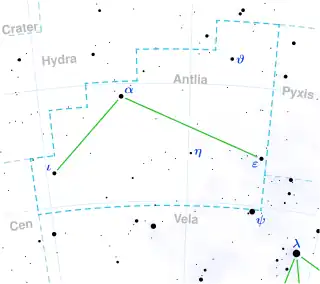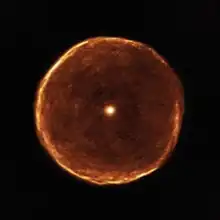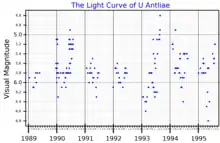U Antliae
U Antliae (U Ant) is a variable star in the constellation Antlia. It is a carbon star surrounded by two thin shells of dust.
 | |
| Observation data Epoch J2000 Equinox J2000 | |
|---|---|
| Constellation | Antlia |
| Right ascension | 10h 35m 12.852s[1] |
| Declination | −39° 33′ 45.32″[1] |
| Apparent magnitude (V) | 5.27 - 6.04[2] |
| Characteristics | |
| Evolutionary stage | AGB |
| Spectral type | C-N3[3] (C5,3[4]) |
| U−B color index | 7.10[5] |
| B−V color index | 2.84[5] |
| Variable type | LB[6] |
| Astrometry | |
| Radial velocity (Rv) | 41.00[7] km/s |
| Proper motion (μ) | RA: −31.372±0.228[8] mas/yr Dec.: 2.371±0.267[8] mas/yr |
| Parallax (π) | 3.5717 ± 0.2043 mas[8] |
| Distance | 910 ± 50 ly (280 ± 20 pc) |
| Absolute magnitude (MV) | −1.87[9] |
| Details | |
| Radius | 325[10] R☉ |
| Luminosity | 8,000[11] L☉ |
| Temperature | 2,800[11] K |
| Other designations | |
| Database references | |
| SIMBAD | data |

U Antliae is an extremely red C-type carbon star. These cool stars on the asymptotic giant branch are further reddened by strong mass loss and dust that forms around the star. U Antliae is calculated to have an effective surface temperature of 2,800 K, although the light that reaches us has an appearance more like that from a black body with a temperature of 2,300 K surrounded by dust at a temperature of 72 K.[11] It emits most of its radiation in the infrared and although it is only about 500 times brighter than the sun at visual wavelengths,[9] its bolometric luminosity is 8,000 times higher than the Sun's.[11]

U Antliae is an irregular variable star with an apparent magnitude that varies between 5.27 and 6.04. Approximately 900 light years from Earth, it is surrounded by two shells of dust, thought to have been ejected 14,000 and 10,000 years ago.[13] The exact origin and structure of the shells is uncertain, possibly due to enhanced mass loss during thermal pulses, possibly due to interaction of the stellar wind with interstellar material.[11]
References
- van Leeuwen, F. (2007). "Validation of the new Hipparcos reduction". Astronomy and Astrophysics. 474 (2): 653–664. arXiv:0708.1752. Bibcode:2007A&A...474..653V. doi:10.1051/0004-6361:20078357. S2CID 18759600.Vizier catalog entry
- Otero, Sebastian (3 November 2011). "U Antliae". AAVSO Website. American Association of Variable Star Observers. Retrieved 25 July 2014.
- De Mello, A. B.; Lorenz-Martins, S.; De Araújo, F. X.; Bastos Pereira, C.; Codina Landaberry, S. J. (2009). "NSCC—A New Scheme of Classification of C-Rich Stars Devised from Optical and Infrared Observations". The Astrophysical Journal. 705 (2): 1298. arXiv:0910.4086. Bibcode:2009ApJ...705.1298D. doi:10.1088/0004-637X/705/2/1298. S2CID 119275102.
- Yamashita, Y. (1975). "The C-classification of spectra of carbon stars. II". Tokyo. 15: 47. Bibcode:1975AnTok..15...47Y.
- Ducati, J. R. (2002). "VizieR Online Data Catalog: Catalogue of Stellar Photometry in Johnson's 11-color system". CDS/ADC Collection of Electronic Catalogues. 2237. Bibcode:2002yCat.2237....0D.
- Samus, N. N.; Durlevich, O. V.; et al. (2009). "VizieR Online Data Catalog: General Catalogue of Variable Stars (Samus+ 2007-2013)". VizieR On-line Data Catalog: B/GCVS. Originally Published in: 2009yCat....102025S. 1. Bibcode:2009yCat....102025S.
- Gontcharov, G. A. (2006). "Pulkovo Compilation of Radial Velocities for 35 495 Hipparcos stars in a common system". Astronomy Letters. 32 (11): 759–771. arXiv:1606.08053. Bibcode:2006AstL...32..759G. doi:10.1134/S1063773706110065. S2CID 119231169.
- Brown, A. G. A.; et al. (Gaia collaboration) (August 2018). "Gaia Data Release 2: Summary of the contents and survey properties". Astronomy & Astrophysics. 616. A1. arXiv:1804.09365. Bibcode:2018A&A...616A...1G. doi:10.1051/0004-6361/201833051. Gaia DR2 record for this source at VizieR.
- Alksnis, A.; Balklavs, A.; Dzervitis, U.; Eglitis, I. (1998). "Absolute magnitudes of carbon stars from HIPPARCOS parallaxes". Astronomy and Astrophysics. 338: 209. Bibcode:1998A&A...338..209A.
- De Beck, E.; Decin, L.; De Koter, A.; Justtanont, K.; Verhoelst, T.; Kemper, F.; Menten, K. M. (2010). "Probing the mass-loss history of AGB and red supergiant stars from CO rotational line profiles. II. CO line survey of evolved stars: Derivation of mass-loss rate formulae". Astronomy and Astrophysics. 523: A18. arXiv:1008.1083. Bibcode:2010A&A...523A..18D. doi:10.1051/0004-6361/200913771. S2CID 16131273.
- Kerschbaum, F.; Ladjal, D.; Ottensamer, R.; Groenewegen, M. A. T.; Mecina, M.; Blommaert, J. A. D. L.; Baumann, B.; Decin, L.; Vandenbussche, B.; Waelkens, C.; Posch, T.; Huygen, E.; De Meester, W.; Regibo, S.; Royer, P.; Exter, K.; Jean, C. (2010). "The detached dust shells of AQ Andromedae, U Antliae, and TT Cygni". Astronomy and Astrophysics. 518: L140. arXiv:1005.2689. Bibcode:2010A&A...518L.140K. doi:10.1051/0004-6361/201014633. S2CID 55820070.
- "Download Data". aavso.org. AAVSO. Retrieved 1 October 2021.
- Izumiura, H.; Waters, L. B. F. M.; de Jong, T.; Loup, C.; Bontekoe, Tj. R.; Kester, D. J. M. (1997). "A double dust shell surrounding the carbon star U Antliae". Astronomy and Astrophysics. 323: 449–60. Bibcode:1997A&A...323..449I.